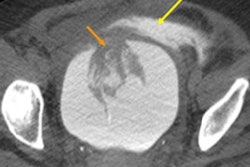
The combination of renal ultrasound and cystoscopy is the most cost-effective strategy for evaluating patients with asymptomatic microscopic hematuria (AMH), potentially saving hundreds of millions of dollars compared with CT and cystoscopy, according to research published online April 17 in JAMA Internal Medicine.
After performing a literature review and developing a decision-analysis model, a team of researchers led by Dr. Joshua Halpern of Weill Cornell Medicine found that ultrasound and cystoscopy together produced an incremental cost per cancer detected (ICCD) of $53,810. The combination of CT and cystoscopy -- currently recommended by the American Urological Association (AUA) -- would have detected just one additional cancer at an ICCD of more than $6 million.
The researchers believe that if it were implemented nationwide, the protocol of ultrasound and cystoscopy would save as much as $390 million each year -- while missing few cancers.
"The use of ultrasound in lieu of CT as the first-line diagnostic strategy will optimize cancer detection and reduce costs associated with evaluation of AMH," they wrote. "Given our findings, we need to critically evaluate the appropriateness of our current clinical practices, and potentially alter our guidelines to reflect the most effective screening strategies for patients with AMH."
A harbinger of malignancy?
Asymptomatic microscopic hematuria is found in as many as 40.9% of adults in the U.S. on urinalysis, and it has a number of potential etiologies. A genitourinary malignant abnormality is a particular concern; studies in the literature have reported that up to 11% of patients with AMH have been found to have a malignant abnormality, according to the authors (JAMA Intern Med, April 17, 2017).
"The high prevalence of AMH and its role as a potential harbinger of malignant abnormality confers great importance on the diagnostic algorithm for its evaluation," the researchers wrote.
Current guidelines vary: The American Urological Association recommends a protocol of CT and cystoscopy, while others such as the Dutch Guideline on Hematuria and the Canadian Urological Association suggest the use of renal ultrasound and cystoscopy. Even with the AUA guidelines, many practitioners in the U.S. are actually using ultrasound in lieu of CT for AMH, according to the authors.
The AUA-recommended strategy subjects patients to tests that are associated with considerable morbidity risk, including procedural discomfort, urinary tract infection, contrast-enhanced nephropathy, and radiation exposure. All of these costs must be weighed against the relatively low risk of a malignant abnormality, they wrote.
Hypothesizing that the replacement or exclusion of CT would considerably lower costs while minimally affecting cancer detection, the research team sought to determine the relative cost per cancer detected when evaluating AMH using four diagnostic protocols:
- CT alone
- Cystoscopy alone
- CT and cystoscopy
- Renal ultrasound and cystoscopy
The researchers did not evaluate the use of ultrasound alone due its low sensitivity for detecting lower tract malignant abnormalities, which account for the majority of malignant genitourinary abnormalities in patients with AMH.
Halpern and colleagues developed a decision-analytic model to perform cost-effectiveness analysis based on data from studies in the literature. The key data inputs included cancer incidence, diagnostic test accuracy, complications, and guideline compliance. The downstream consequences of each diagnostic evaluation were also incorporated into the model, the authors noted.
They evaluated cost inputs from the payor perspective and updated the figures to 2016 dollars by using the medical care component of the Consumer Price Index. They also calculated national average nonfacility costs associated with diagnostic tests from the Medicare Physician Fee Schedule and the Medicare Clinical Laboratory Fee Schedule.
The analysis included adult patients with AMH found on routine urinalysis; additional analysis was performed for subgroups of patients deemed to be at high risk (men, smokers, those 50 years of age and older) who were found in the primary care or urologic referral setting.
Ultrasound bests CT
The combination of ultrasound and cystoscopy was by far the most cost-effective strategy.
| Performance of diagnostic strategies in evaluating AMH | ||||
| CT alone | Cystoscopy alone | CT and cystoscopy | Ultrasound and cystoscopy | |
| Cancer detection rate per 10,000 patients | 221 | 222 | 246 | 245 |
| Incremental cost per cancer detection | Dominated by other strategies | $10,287 | $6,480,484 | $53,180 |
"Replacing ultrasound with CT detected just one additional cancer at an ICCD of $6,480,484, far exceeding the willingness-to-pay threshold," the authors wrote.
The model was not sensitive to variations in the data variables, and ultrasound and cystoscopy was also the dominant strategy in 100% of simulations performed using probabilistic sensitivity analysis. Furthermore, ultrasound and cystoscopy remained the most cost-effective strategy in the subgroup analysis of high-risk patients, according to the group.
National savings
The researchers noted that in 2012, the diagnosis of microscopic hematuria was associated with 485,222 patient visits (2.7% overall) to urologists. Assuming that urologists had 100% compliance with the guidelines, using CT instead of ultrasound would detect 60.2 additional cancers nationally at an incremental cost of nearly $390 million. If compliance with the guidelines was imperfect, using CT instead of ultrasound would find anywhere from three to 38 additional cancers at an incremental cost ranging from more than $19 million to nearly $246 million.
Halpern and colleagues concluded that the combination of renal ultrasound and cystoscopy is the most cost-effective approach for evaluating AMH.
"The superiority of this approach over the use of CT and cystoscopy is driven primarily by the higher costs of CT and its associated complications, albeit rare," they wrote. "Given the low prevalence of upper tract malignant abnormalities in patients with AMH, the small advantage in the sensitivity of CT imaging modalities does not compensate for the significant additional costs. Likewise, CT and cystoscopy was not a cost-effective first-line approach among patients with higher risk of malignant abnormality, because the absolute risk of malignant abnormality in this group remains low."
Important findings
In an accompanying invited commentary, Dr. Leslee Subak of the University of California, San Francisco (UCSF) said the findings are important and provide useful data for national and international guideline groups as they reconsider recommendations. They would also be of value for clinicians in making decisions about evaluating AMH, she wrote.
She also noted -- in agreement with the study's authors -- that the testing strategy should be customized to the needs of the patient.
"While cystoscopy plus renal ultrasound should be the preferred approach for initial evaluation, testing should be individualized based on shared decision-making, patient characteristics, such as risk factors for genitourinary cancer, the results of prior evaluations, and patient preferences," she wrote. "The results of this cost-effectiveness analysis provide helpful data to improve high-value care."





















